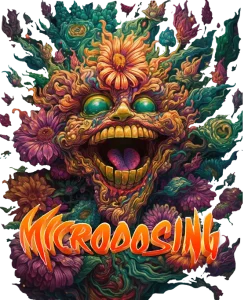Understanding Different Psychedelic Approaches
The world of psychedelics has garnered increasing attention in recent years, not only for its potential in treating mental health conditions but also for the variety of ways these substances can be consumed. Two prominent methods of consumption that have captured the public’s interest are microdosing and macrodosing. These approaches are vastly different in terms of the dosage, effects, and goals, yet both have gained significant popularity for their respective benefits.
Understanding the differences between microdosing and macrodosing is key to determining which approach might best suit an individual’s needs, whether for therapeutic purposes, personal growth, or cognitive enhancement. In this article, we will explore both methods in depth, examining how they work, their effects, and the types of benefits people seek from each.
What Is Microdosing?
Microdosing involves taking a very small, sub-perceptual dose of a psychedelic substance, such as LSD or psilocybin. The dose is typically about 1/10th to 1/20th of a full hallucinogenic dose, meaning that the individual does not experience any overt psychedelic effects, such as hallucinations or a “trip.” Instead, the goal of microdosing is to subtly enhance cognitive functioning, emotional well-being, and creativity without disrupting daily activities.
The practice of microdosing has gained a strong following in recent years, especially in professional and creative circles where individuals seek to boost productivity, improve mood, and enhance focus. It has been popularized in Silicon Valley, where some professionals use it as a tool for cognitive enhancement, similar to the way nootropics are used.
1. How Microdosing Works
Microdosing typically follows a structured schedule, such as taking a microdose every three days or following a regimen of two days on, two days off. The key is consistency and moderation, as the goal is not to experience intense effects but to maintain a low-level enhancement of mental and emotional states.
The exact mechanisms by which microdosing works are not fully understood, but it is believed that the small doses of psychedelics activate serotonin receptors in the brain, particularly the 5-HT2A receptor, which plays a role in regulating mood, cognition, and perception. By subtly altering serotonin levels, microdosing may promote increased neuroplasticity, helping individuals think more flexibly and creatively.
2. Benefits of Microdosing
Proponents of microdosing report a variety of benefits, including:
- Enhanced focus and concentration: Many people who microdose claim they experience improved cognitive functioning, allowing them to concentrate more easily and work more efficiently.
- Improved mood and emotional well-being: Some individuals use microdosing to alleviate symptoms of depression, anxiety, or general mood disturbances. The low-level serotonin activation can lead to a more positive outlook and emotional resilience.
- Increased creativity and problem-solving abilities: Artists, writers, and entrepreneurs often turn to microdosing to stimulate their creativity and think outside the box. Microdosing may enhance divergent thinking, allowing individuals to generate new ideas and solutions to problems.
- Reduced symptoms of anxiety and depression: Some users find that microdosing helps manage mental health issues, though more research is needed to fully understand its therapeutic potential.
While many people report positive effects, it’s important to note that scientific studies on microdosing are still in the early stages. Much of the evidence for its benefits remains anecdotal, and more research is needed to confirm its efficacy and long-term safety.
What Is Macrodosing?
Macrodosing, on the other hand, involves taking a full, often hallucinogenic dose of a psychedelic substance, such as psilocybin, LSD, or ayahuasca. Unlike microdosing, macrodosing leads to a significant alteration of perception, consciousness, and emotional states, often resulting in a “trip.” This approach is typically used in therapeutic or spiritual contexts where the goal is to have a profound, transformative experience.
Macrodosing is known for its ability to induce deep introspective journeys, mystical experiences, and even encounters with the subconscious mind. It has been used for centuries in shamanic and spiritual practices and is increasingly being studied for its therapeutic potential, particularly in treating mental health conditions like PTSD, depression, and addiction.
1. How Macrodosing Works
Macrodosing works by fully activating the brain’s serotonin receptors, particularly the 5-HT2A receptor, which is responsible for the sensory and cognitive changes associated with a psychedelic experience. The high dosage of psychedelics can lead to intense visuals, heightened emotions, and altered perceptions of time and space.
Unlike microdosing, macrodosing typically requires a controlled environment and often a guide or therapist to help the individual navigate the experience, especially when the purpose is therapeutic. The effects of macrodosing can last several hours, and the intensity of the experience can vary depending on the substance, dosage, and individual.
2. Benefits of Macrodosing
Macrodosing is not taken lightly, as it often results in intense, life-altering experiences. Some of the reported benefits include:
- Deep emotional healing: Many individuals who macrodose report being able to confront and process past traumas, difficult emotions, and psychological blockages that they could not address through traditional therapy.
- Spiritual or mystical experiences: Macrodosing often leads to experiences that individuals describe as mystical or transcendent, such as feeling connected to the universe or having a sense of oneness with all living things. These experiences can have lasting effects on a person’s worldview and sense of purpose.
- Breakthroughs in mental health treatment: Clinical studies have shown that macrodosing psychedelics, such as psilocybin, can have profound therapeutic effects, particularly for individuals suffering from treatment-resistant depression, PTSD, or substance use disorders. A single macrodose session, in combination with therapy, can lead to long-lasting improvements in mental health.
- Increased self-awareness and insight: Macrodosing allows individuals to explore their subconscious mind, gaining insight into their behaviors, thought patterns, and emotional responses. This level of self-awareness can foster personal growth and help individuals make meaningful life changes.
Microdosing vs. Macrodosing: Key Differences
While both microdosing and macrodosing involve the use of psychedelic substances, they are vastly different in terms of the experience and the intended outcomes. Here are some of the key differences:
1. Dosage
- Microdosing: Involves taking very small, sub-perceptual doses (usually around 1/10th of a regular dose).
- Macrodosing: Involves taking a full or significant dose, leading to strong hallucinogenic effects.
2. Effects
- Microdosing: Subtle, often unnoticed by the user; designed to improve mood, cognition, and productivity without inducing a “trip.”
- Macrodosing: Intense and immersive, with hallucinatory effects, emotional shifts, and altered states of consciousness.
3. Purpose
- Microdosing: Typically used to enhance daily life, improve focus, creativity, and emotional balance, while continuing with regular activities.
- Macrodosing: Usually intended for deep healing, spiritual exploration, or addressing significant mental health issues in a controlled setting.
4. Time Commitment
- Microdosing: Minimal disruption to daily life, as the effects are subtle and short-lived.
- Macrodosing: Requires a significant time commitment, often lasting several hours, with recovery time needed afterward.
5. Risk and Considerations
- Microdosing: Generally considered lower risk, but since research is limited, the long-term effects are not fully understood.
- Macrodosing: Can lead to intense emotional or psychological experiences that may be challenging to handle without proper guidance or a supportive environment.
Which Approach Is Right for You?
Choosing between microdosing and macrodosing depends on your goals, needs, and comfort level with psychedelic experiences.
- Microdosing may be the right choice for individuals looking for subtle, incremental improvements in mood, focus, or creativity. It’s also a popular option for those who want to explore the potential benefits of psychedelics without experiencing the intense effects of a full dose.
- Macrodosing, on the other hand, is better suited for those seeking deep emotional healing, spiritual exploration, or breakthrough treatments for mental health conditions. However, it’s essential to undertake macrodosing in a safe, supportive environment, preferably with a trained guide or therapist.
Both approaches have their own unique benefits, and with the right preparation and intention, either method can provide meaningful insights and lasting benefits.
Conclusion: Two Paths, One Purpose
Microdosing and macrodosing represent two different approaches to harnessing the power of psychedelics, each with its own strengths and applications. Whether you’re seeking subtle enhancements to your daily life or profound personal transformation, both methods offer a unique way to explore the mind and unlock new potentials.
As research continues to expand in the field of psychedelics, individuals will have more information to guide their choices and more options to integrate these substances into their lives safely and effectively.

